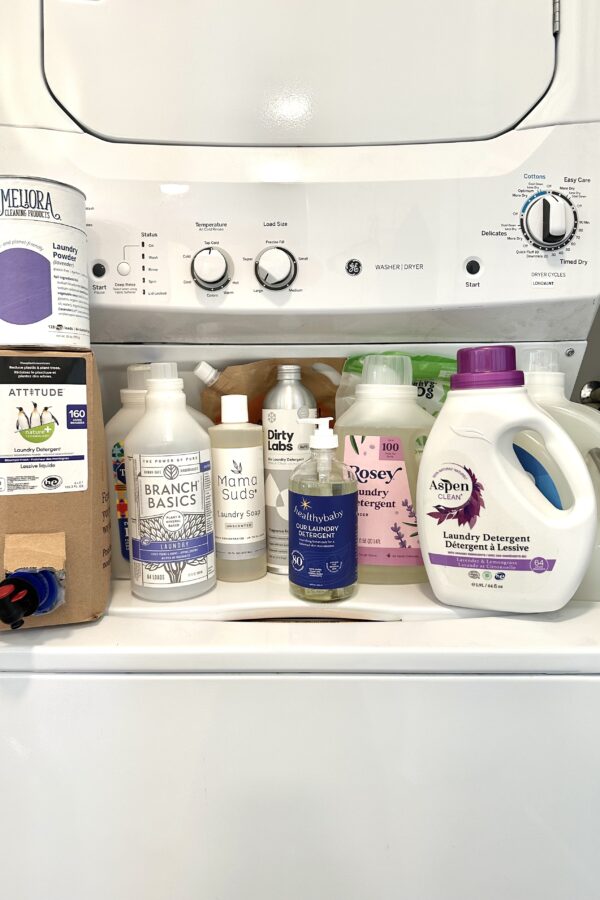Written by Karen C.
Weeds can rob our lawns and gardens of water, nutrients, and light, and they can crowd the plants we want to grow. Sometimes, weeds may even cause our flowers, vegetables, and lawns to die off.
But many weed killers are toxic. So how do we remove weeds without harming other plants, the environment, wildlife, and our families?
Through the years, chemical control has been the number one method for weed killers. Most synthetic-chemical-based herbicides have historically worked by way of mass destruction, with the goal of killing everything they touch.
But in doing so, they leave behind hazardous residue on our vegetables, in the air, in our yards, and in the surrounding environments.
You don’t have to use such intense and harmful chemicals for the pesky weeds that are taking over your grasses and plants.
There are better weed killers on the market that can give you safe, organic, and environmentally-friendly protection for your lawn and gardens.
Conquer your lawn safely and effectively with the 8 best store-bought organic, eco-friendly, and non-toxic weed-killers recommended below.
Non-Toxic Weed Killers in a Nutshell:
- Traditional weed-killers contain hazardous ingredients that can harm our families, pets, and the environment.
- Ensure you know whether you’re looking for a selective or non-selective weed-killer before you begin shopping.
- We list 8 eco-friendly and non-toxic weed-killers that can effectively treat the problem of weeds while keeping your lawn & garden organic and your family safe.
Table of Contents
- Toxic Ingredients Common in Weed Killers
- Organic and Non-Toxic Herbicides You Have at Home
- Selective vs. Non-Selective Weed Killers
- ALL Weed Killers Should Be Used Carefully
- The Best Organic, Non-Toxic, & Eco-Friendly Weed Killer Brands for Lawns & Gardens
- Non-Selective Non-Toxic Weed Killers (Not for Widespread Use on Lawns)
- Earth’s Ally
- Green Gobbler 20% Vinegar Weed and Grass Killer
- Natural Armor Weed and Grass Killer
- Dr. Earth Final Stop Weed & Grass Killer
- ECO Garden Pro Weed and Grass Killer
- Natural Elements Weed Killer
- Better Yet: Pull Weeds Out By Hand!
This guide contains affiliate links, which means we may earn a commission if you decide to make a purchase. As always, we only make honest recommendations.
Toxic Ingredients Common in Weed Killers
Despite the benefits of applying chemical weed killers, the harmful effects on the environment, your plants and vegetables, and your family are a real concern.
Before I get into safer alternatives (including ones you can use DIY your own weed killers if you want to), let’s look at a few of the toxic herbicide ingredients that can be hazardous to your family and the wildlife in your backyard:
Atrazine
Banned in 44 countries throughout Europe, Asia, Africa, and South America, atrazine is the second-most widely used pesticide in the US.
There are plenty of human and mammal studies showing atrazine is an endocrine-disruptor, and research links it to other health concerns as well, including birth defects, cancer, and more.
2,4-D
Despite the fact that it’s still used in parks, athletic fields, and on crops, dichlorophenoxyacetic acid (aka 2,4-D) is listed as a “possible human carcinogen” by the IARC and it is suspected to be an endocrine-disruptor.
Long-term exposure is associated with liver and kidney damage, and short-term acute exposure can cause things like severe burning in the throat and chest, skin rash, vomiting, and more.
It is banned in countries like Denmark, Norway, and certain provinces in Canada.
Dicamba
According to the EPA, dicamba is deemed unlikely to cause cancer; however, certain studies have indicated a higher cancer risk among dicamba users. Additionally, exposure to dicamba has been associated with greater likelihood of developing hypothyroidism.
In 2020, a federal court ordered Bayer/Monsanto and other producers to stop selling dicamba-based herbicides. However, the EPA is effectively ignoring this court order and was sued because of it.
In February 2024, a federal judge in Arizona issued a ban on dicamba-based herbicides produced by three companies, citing unlawful approval by the EPA. This decision marked the second instance of a federal court banning dicamba herbicides since their introduction for the 2017 growing season.
Glyphosate
I’m sure you’ve heard about glyphosate. It was first used in Roundup in 1974, and since then, many herbicides have started using glyphosate.
Glyphosate is a controversial one, to say the least. Maybe in the future, we’ll do a deep dive into the rabbit hole that is Monsanto/Bayer and their legal battles over glyphosate, but for now, I’ll just say that I do not recommend it as a non-toxic choice.
Glyphosate was listed as a probable carcinogen by the IARC and Monsanto has paid billions of dollars in damages in lost court cases in recent years. (I recommend subscribing to Carey Gillam’s Substack, UnSpun, to stay updated on the current lawsuits against the chemical giant.)
Despite the fact that they keep arguing that it’s “safe,” Bayer/Monsanto said that it would pull glyphosate-based roundup from the shelves in 2023 so that it would no longer be available to consumers. It’s 2024 now, and although I have noticed that some of the Roundup in stores has been switched to a glyphosate-free formula, it still seems to be pretty easy to find glyphosate in stores.
Then there are som other toxic herbicides that are commonly used in agriculture and by professional landscapers, but are not approved for at-home use by consumers including paraquat.
Organic and Non-Toxic Herbicides You Have at Home
If you’re looking to DIY a weed killer, here are some ingredients that can be effective:
- Vinegar
- Salt
- Clove oil
- Cinnamon
- Rosemary
- Corn gluten
- Citric acid/oil
Considering these are fairly common ingredients that you likely have at home already, you might want to try and make your own recipe.
However, if you don’t want to go through that effort, there are natural lawn care brands that have tested and perfected their own formulations using various combinations and ratios of the above ingredients.
The Organic Materials Review Institute (OMRI) reviews organic weed killers. You can research products at OMRI to see the products they say are organic.
But, before I get into the list of non-toxic and more environmentally friendly weed killers, you first need to identify if you’re looking for a selective or non-selective weed killer.
Selective vs. Non-Selective Weed Killers
Before you choose which weed killer is best for you, you need to decide if you want to use a “selective” or “non-selective” weed killer. Choosing the wrong one and applying it incorrectly could result in a lot of dead flowers, veggies, or grass!
Selective weed killer
If you’re going to be spraying weed killer over your lawn or wide swaths of your garden, a selective weed killer is best. This will ensure that the weeds are killed, but your lawn grass, flowers, and vegetables are not.
Non-selective weed killer
On the other hand, non-selective weed killers should only be used directly on the weeds you want to get rid of.
I’ve included recommendations for both options so you can choose what’s best for you.
ALL Weed Killers Should Be Used Carefully
One more thing to note: remember that any and all herbicides (even the safe & natural ones) are meant to kill things. All of them can have side effects if you use too much of them or if you use them improperly. It’s important that no matter which brand you choose, that you follow the manufacturer’s directions and use common sense.
The Best Organic, Non-Toxic, & Eco-Friendly Weed Killer Brands for Lawns & Gardens
There aren’t very many selective non-toxic and organic weed killers on the market, but here are the ones I recommend:
Sunday
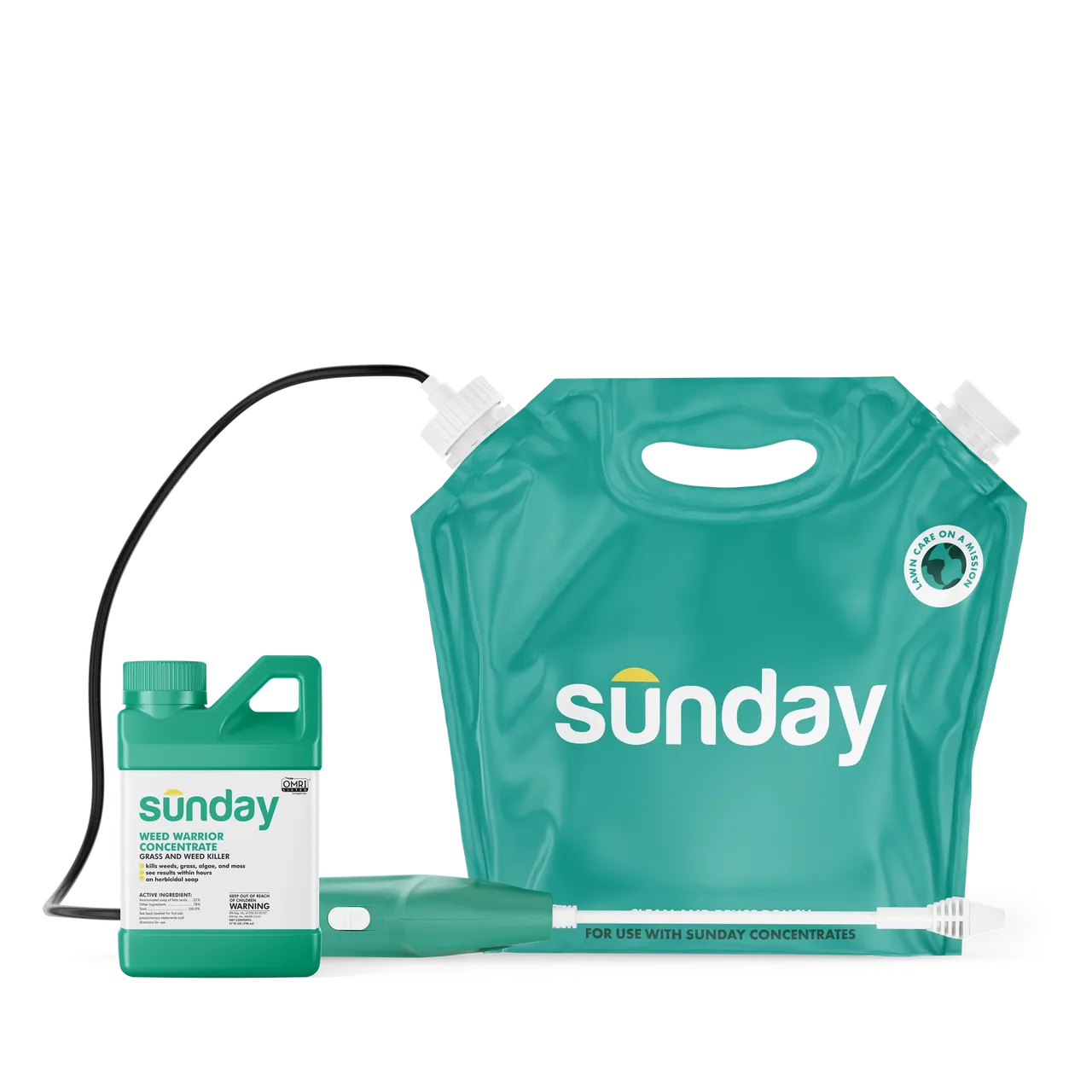
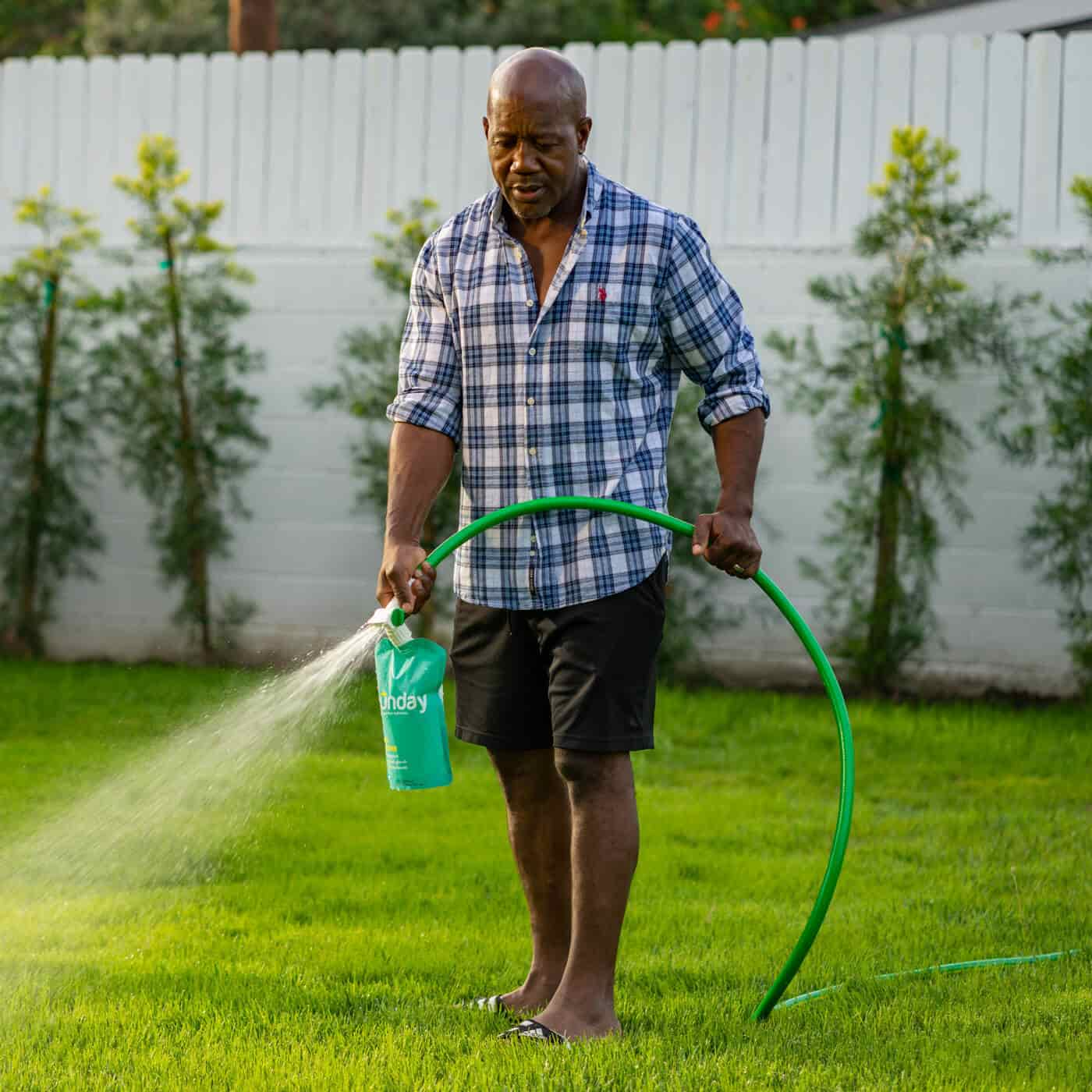
A first-of-its-kind lawn care company, Sunday makes a line of lawn-safe weed killers that are made from eco-friendly ingredients. It can take care of things like:
- Dandelion
- Thistle
- Moss
- Speedwell species
- White clover
- Mustards
- Rust
- Snow mold
- Moss
- Algae
- Lichens and more
Their two main weed control products are Dandelion Doom and Weed Warrior, both of which can be purchased as a concentrate or in a spot treatment spray bottle. You can also purchase a Starter Pack first and then get refills later.
The Dandelion Doom uses iron to kill weeds at their roots. The Weed Warrior, on the other hand, uses a type of soap made from fatty acids, which “eats away at the waxy coating that protects most green leafy growth from the elements.” You can learn more about Sunday’s different ingredients on their website.
In addition to their weed control products, Sunday also carries a variety of other glyphosate-free garden and lawn-care products, including fertilizers, pest controls, live plants, and more. If you want a more comprehensive approach to your lawn and garden care, they can help you set up a “Smart Lawn Plan.”
They’re also a member of 1% For the Planet (just like us!), meaning they give back a portion of their revenue to environmental non-profits.
Espoma Organic Weed Preventer
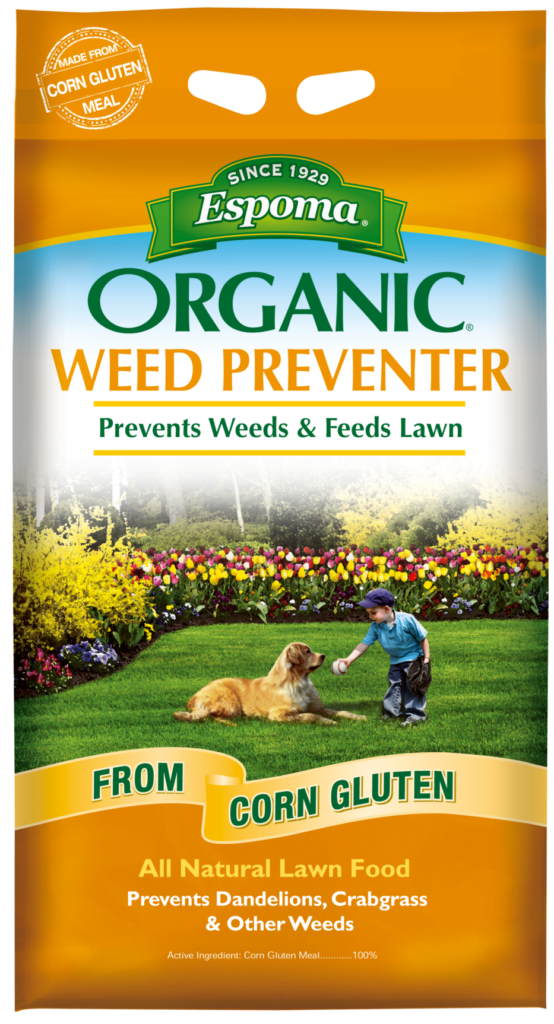
Espoma Organic Weed Preventer is one of the few organic weed killers available for lawns. It’s manufactured with a natural corn gluten meal that not only kills weeds but feeds the lawn.
It’s a pre-emergent herbicide, which means it prevents the weeds from germinating on your lawn. So, it doesn’t kill established weeds. Apply it in the spring before weeds emerge for the best results.
Also, children and pets can walk on the grass right after applying it to your lawn.
On the environmental front, Espoma is approved for organic use by the California Dept. of Food and Agriculture; they have a certificate of Environmental Stewardship; and their 43,000 square foot manufacturing facility is 100% solar powered.
Shop Espoma Organic Weed Preventer at:
Walmart
Ace Hardware
Or your local nursery or garden supply store
Non-Selective Non-Toxic Weed Killers (Not for Widespread Use on Lawns)
The following weed killers are non-selective herbicides, which means they can damage any plants they come into contact with, including your lawn grass. These weed killers should be sprayed directly on the weeds you want to get rid of, in cracks in the driveway, etc.
Earth’s Ally
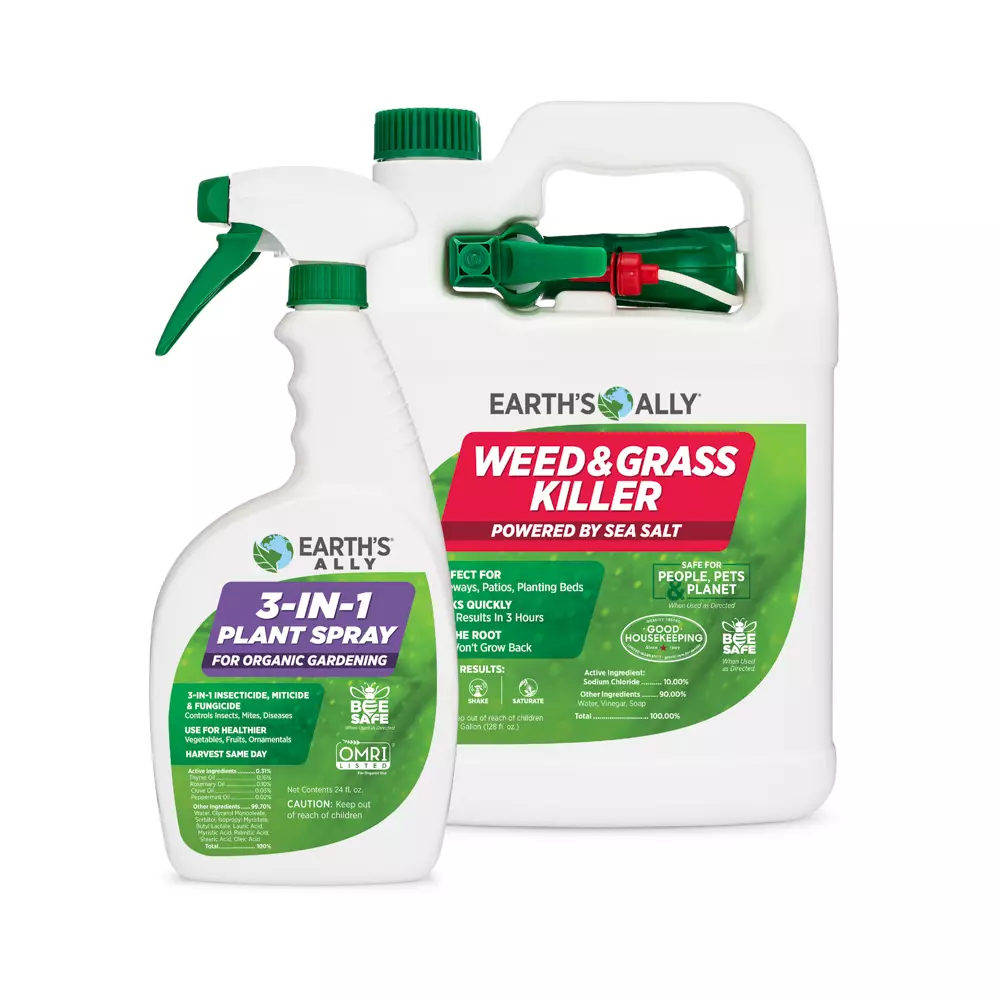
Earth’s Ally uses salt as its main weed-killing ingredient, and they combine it with other ingredients like vinegar and soap. It kills common weeds at the root including:
- Broadleaf
- Crabgrass
- Dandelion
- Clover
- Ivy
- Chickweed and more
You can see it start working in about three hours so that you don’t end up over-spraying. Then after about a week, the weeds are completely dead.
They also have other organic lawn care and gardening products, including general plant spray, insect control, and disease control. They transparently list all of their ingredients right on their website.
Plus, not only are Earth’s Ally’s products “Bee Safe®”, but they even donate 5% of profits to pollinator conservation efforts.
Shop Earth’s Ally at:
Green Gobbler 20% Vinegar Weed and Grass Killer
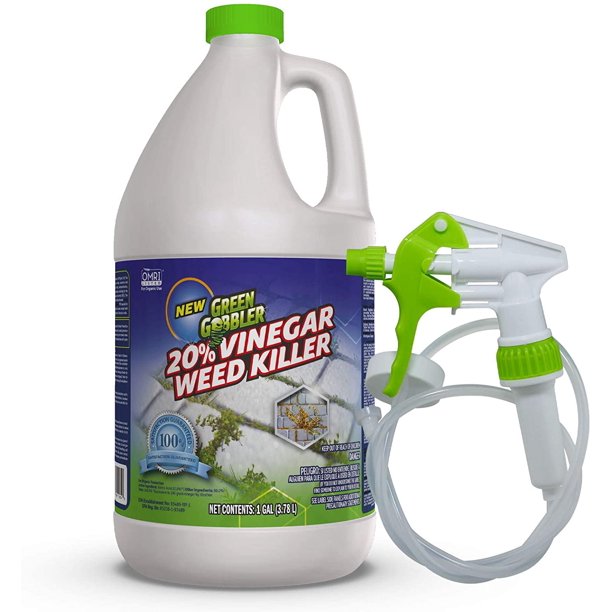
Naturally made from corn, Green Gobbler Weed Killer is an organic alternative to harsh, chemical herbicides. It advertises that it kills weeds starting within one hour and destroys all weeds within 24 hours.
Green Gobbler is certified organic and safe to use anywhere in your yard and garden.
The phosphate- and glyphosate-free ingredients work on:
- Crabgrass
- Dandelions
- Nutsedge
- Moss and clover
- Plus other weeds.
The active ingredients in this herbicide are made from vinegar derived from corn. The product states that it’s four times stronger than household vinegar.
Natural Armor Weed and Grass Killer
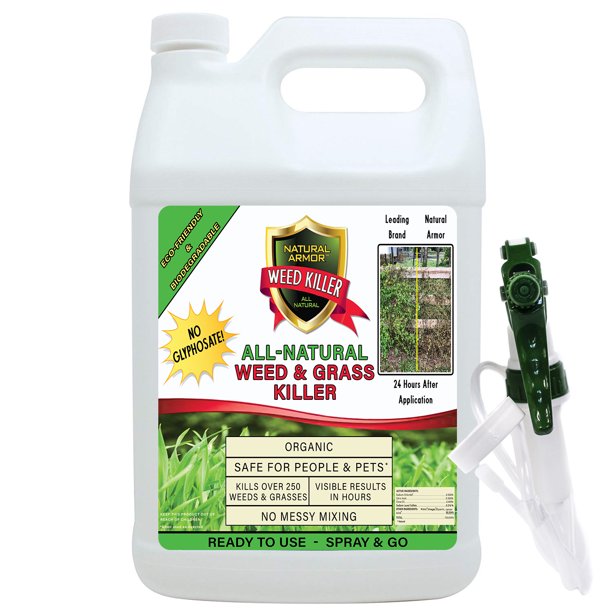
Natural Armor natural, organic weed and grass killer is also glyphosate-free. It kills over 250 types of weeds and grasses.
This herbicide formula is safe for your family, pets, wildlife, and groundwater. It comes ready to use, so there’s no messy mixing. Whether you want to kill weeds in your flower beds, around trees, on patios, or pathways, Natural Armor Weed Killer gives good results.
The all-natural ingredients include:
- Vinegar
- lemon juice
- clove oil
- Glycerin
- sodium chloride
- citric acid and water
Dr. Earth Final Stop Weed & Grass Killer
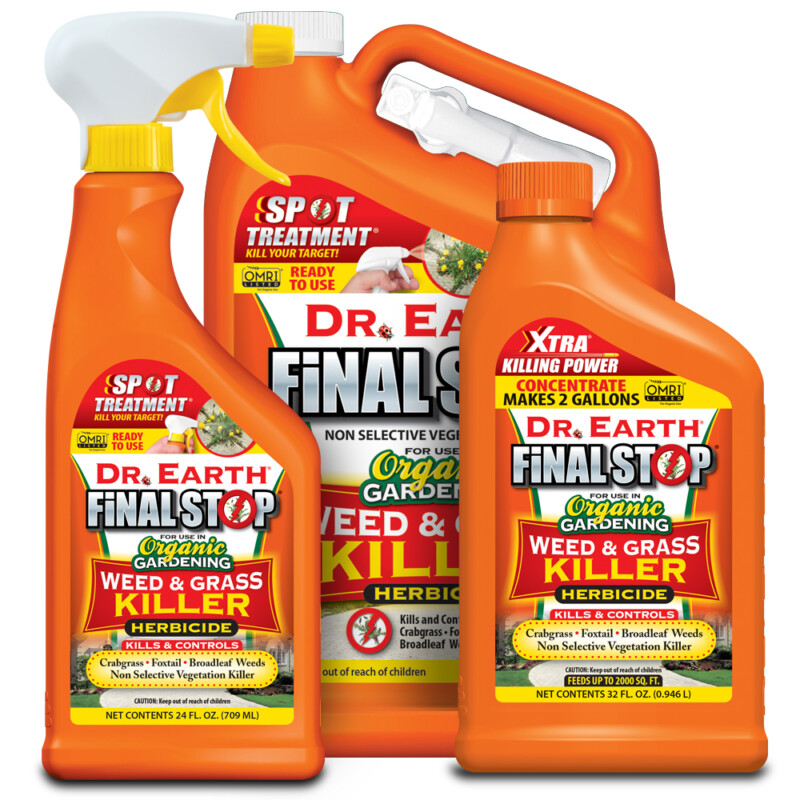
Dr. Earth Final Stop Weed & Grass Killer is an effective, organic weed killer. Its natural ingredients include:
- cinnamon oil
- clove oil
- rosemary oil
- sesame oil
- thyme oil
- and citric acid
It kills grasses and broadleaf weeds anywhere they grow. This organic herbicide formula is safe for pets, wildlife, people, and the environment.
Dr. Earth is non-GMO, pathogen-free, and chicken manure free. They collect human-grade ingredients from supermarkets and farms and upcycle would-be food grade waste into premium fertilizers and soils. In partnership with OceanBound, Dr. Earth helps to recover ocean-bound plastic and estimates they remove 10 million pounds of would-be ocean plastic annually.
ECO Garden Pro Weed and Grass Killer
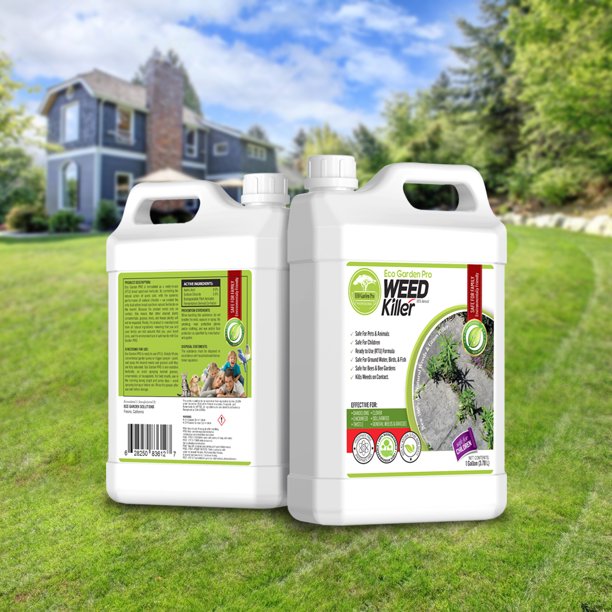
All of the ingredients in this natural weed killer are safe for children, pets, wildlife, bees, and fish. Some of the weeds this product eliminates are:
- Dandelions
- Chickweed
- Crabgrass
- Moss
- And other common weeds.
Eco Garden Pro kills weeds and roots within 24 hours using the active ingredients vinegar and sodium chloride.
The all-natural, organic ingredients are not only non-toxic but also biodegradable and safe for groundwater. It’s an eco-friendly weed solution for flower gardens, sidewalks, and driveways.
Natural Elements Weed Killer
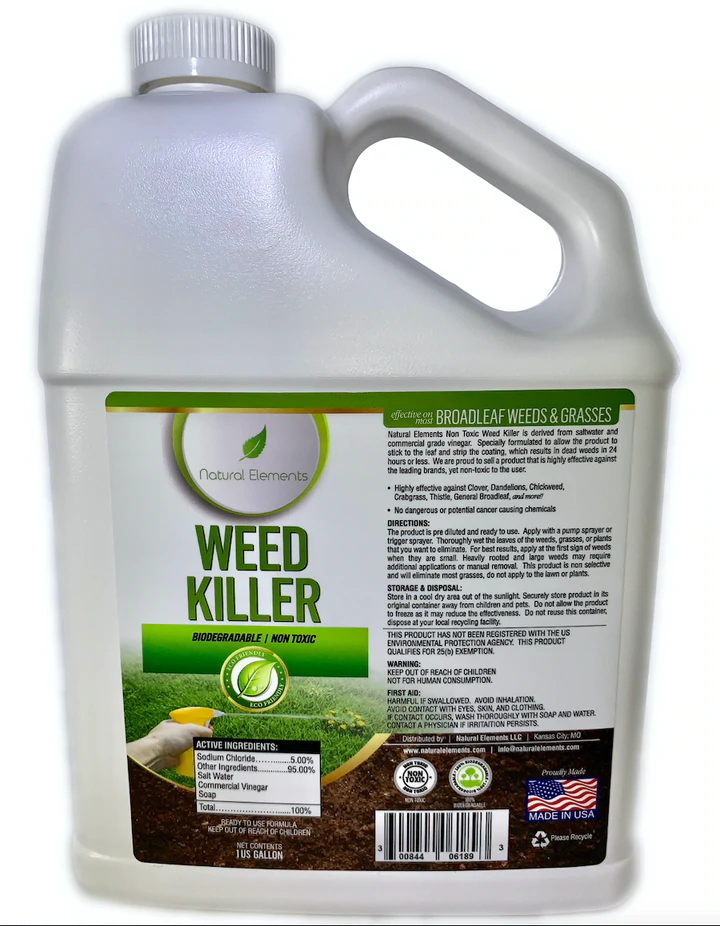
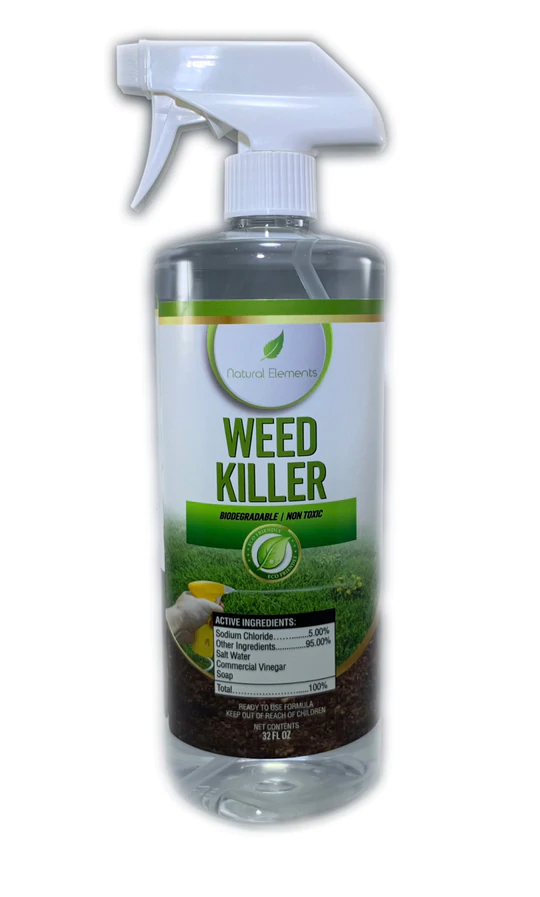
Natural Elements eco-friendly weed killer is safe for your family, pets, and wildlife. The formula doesn’t contain any chemical herbicides and it’s a ready-to-use weed killer.
The ingredients in Natural Elements are:
- Vinegar
- Sodium chloride
- and sodium lauryl sulfate
Better Yet: Pull Weeds Out By Hand!
The least toxic thing you can do to get rid of your weeds is to pull them out manually! Grab some gardening gloves and get pulling. That way, you don’t even have to worry about whether the ingredients in your weed killer spray are safe or not!
The wall of weed killers you’ll run into at any home maintenance can be overwhelming and after a while they all look the same. But if you want to keep your family, your pets, and the environment safe from toxic ingredients you’ll need to look a little deeper. Whether you decide you want to DIY a non-toxic weed killer or not, I hope this article has armed you with the information to help you make the best decision for you.
I hope this guide has been helpful for you in finding the non-toxic and organic lawn weed killer that’s best for your needs.To get more guides, recommendations, and news delivered to your inbox each week, sign up for Filtered Friday.

